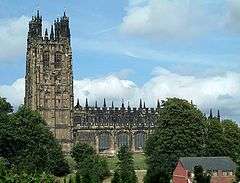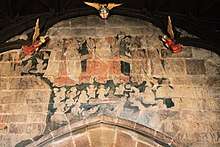St Giles' Church, Wrexham
St Giles' Church is the parish church of Wrexham, Wales, and is a Grade 1 listed building, described by Simon Jenkins as "the glory of the Marches".[1] At 180-feet long, it is the largest medieval Parish Church in Wales. Since 2012, its interior has been re-ordered to include a remodelling of the Chancel as St David's Chapel, and its north aisle is the home of the regimental chapel of the Royal Welch Fusiliers (now part of the Royal Welsh). The core of the present building dates from the 14th century, although it was extensively remodelled in the later 15th century by Thomas, Lord Stanley and his wife Lady Margaret Beaufort (mother of King Henry VII) both of whom are depicted on corbels either side of the chancel arch.[2] In this depiction, Stanley has a crown, but donkey's ears.
| St Giles' Church | |
|---|---|
| The Parish Church of St Giles | |
 "The Glory of the Marches". | |
| Location | Church Street, Wrexham, LL13 8LS |
| Country | Wales |
| Denomination | Church in Wales |
| Website | St Giles' Church |
| History | |
| Status | Active |
| Architecture | |
| Functional status | Parish church |
| Heritage designation | Grade I listed |
| Style | Perpendicular |
| Years built | c. 16th century |
| Administration | |
| Parish | Wrexham |
| Diocese | Diocese of St Asaph |
| Clergy | |
| Vicar(s) | The Revd Dr Jason Bray (Vicar of Wrexham) |
| Curate(s) | The Rev James Tout |
Seven Wonders of Wales

The church's tower is traditionally one of the Seven Wonders of Wales, which are commemorated in an anonymously written rhyme:
- Pistyll Rhaeadr and Wrexham steeple,
- Snowdon's mountain without its people,
- Overton yew trees, St Winefride wells,
- Llangollen bridge and Gresford bells.
The church's tower is mistakenly called a "steeple" in the rhyme. The iconic tower can be seen for many miles around as the tallest building in the town and is a local landmark.
Architecture
The richly-decorated tower, 135-feet high, with its four striking hexagonal turrets, was begun in 1506. It is graced by many medieval carvings including those of an arrow and a deer, the attributes of Saint Giles. The nave arcade is in the Decorated style, and dates from the 14th century, but the remainder of the church is in the late Perpendicular style, and includes an unusual polygonal chancel, similar to that at Holywell, and an echo of the one in the contemporary Henry VII Chapel at Westminster Abbey. Above the present chancel arch are large parts of a 15th-century Doom painting, and the arch beneath shows striking evidence of the tracery which one filled it. It also contains late medieval carvings including on the ceiling wooden polychrome angels playing musical instruments, and a series of later monuments including two by Roubiliac. There are windows by Burne-Jones in the north aisle and a series of windows by Charles Eamer Kempe and C.E. Kempe and Co in the south aisle.[3] The lyrics of the Evangelical hymn "From Greenland's Icy Mountains", written by Reginald Heber, are etched on a window. The hymn was both composed and first performed at the Church in 1819.
.jpg)
Just west of the tower is the grave of Elihu Yale, after whom Yale University in the United States is named, with its long, self-composed epitaph opening with the following lines:
Born in America, in Europe bred,
In Africa travell'd, and in Asia wed,
Where long he lov'd and thriv'd;
At London dead.
The churchyard is entered through wrought-iron gates, completed in 1720 by the Davies Brothers of nearby Bersham, who had been responsible for the gates of Chirk Castle, perhaps the finest example of wrought-iron work in Britain,[4] and also made gates at Sandringham House, and at Leeswood Hall, near Mold in Flintshire.
In 2012, wrexham.com placed a webcam pointed at St Giles giving a live view of the church.[5] June 2012 saw a beacon being lit on top of St Giles as part of the Queen's Diamond Jubilee celebrations.
References
- Simon Jones: Wales: Churches, Houses, Castles (Penguin 2008)
- Simon Jenkins, op cit.
- History of St Giles Archived 2013-07-26 at the Wayback Machine
- John Davies; Nigel Jenkins; Menna Baines (2008). The Welsh Academy encyclopaedia of Wales. University of Wales Press. ISBN 978-0-7083-1953-6.
- Webcam from Wrexham.com, retrieved 3 July 2016
External links
| Wikimedia Commons has media related to St Giles' Church, Wrexham. |
.svg.png)